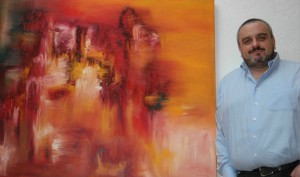
Portrait ![]() |
|
Portrait ![]() |
|
Impressum | Kontakt |
Partner-Links |
Home |
| Portrait | Carmelo Colletti |
|---|---|
|
Carmelo Colletti's own discovery of his artistic talent occurred relatively recently. After his first brief introduction into the world of colour, Colletti worked independently and rapidly in perfecting his personal style. Colletti works in oil on canvas, where he is able to evolve his ideas and fantasy like in a kaleidoscopical way. This determination, this fire and impulsiveness mirrors his native Sicilian culture, which he absorbed to the full until the age of eight years old. The second cultural influence to affect Colletti is the South German region in and around Lörrach, where he arrived in 1972. He has remained loyal to this boarder triangle up until the present day and appreciates the cultural tapestry that transcend the boarders and allows it to flow into his own work in a very personal way. His marked sense of quality that has arisen from the multitude of impressions and experiences is to be seen in his meticulously completed work. At the beginning of his artistic development, he was faced with the decision of moving in a representational or non-representational direction; it was abstraction that achieved the upper hand. Linked to this decision, is also Colletti's conviction that in this flexible medium he can concentrate totally on developing his own style, without the restrictions of producing recognisable images.
The only concession Colletti makes towards representational Art, is in the title. Dominated in the presentation of abstraction and space is the descriptive element of the title, which acts as a pictorial contact to individual experience, knowledge and past visual inputs. Carmelo Colletti retains at every point in his creative development an important amount of flexibility and generosity, in order to give the receptive viewer more than a mere copy of something. Colletti's sensitivity for pictorial space, for colour and the balance between the two, makes for a unique feeling of continually seeing the picture for the first time. The success of his art work is reflected in the numerous inquires for the exhibition of his work, that stretch far over the boarders of the Basel region. |
|
| Text by | Michael Mauch |

 The simple representation of people, objects or landscapes presents
little fascination for him. His creative impulse is too dominant, his spirit
too versatile and his creative will too strong to be limited in this way.
The simple representation of people, objects or landscapes presents
little fascination for him. His creative impulse is too dominant, his spirit
too versatile and his creative will too strong to be limited in this way.